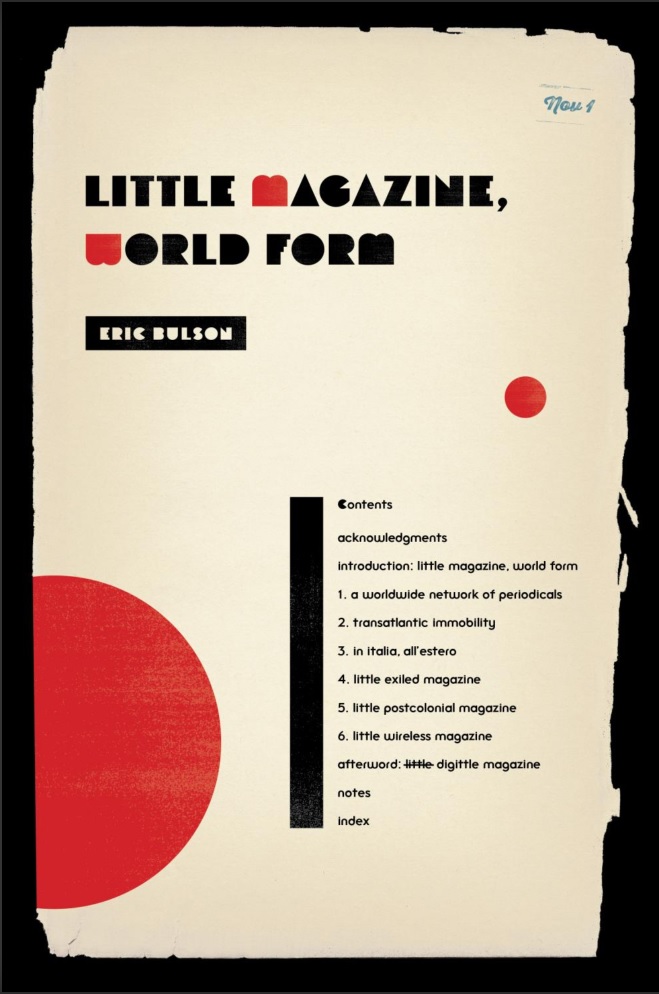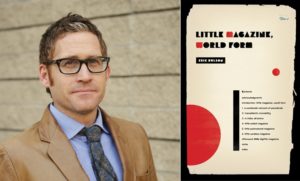What’s next? Little Magazine, World Form

Questions about literary “form” do not generally make good small talk, unless you happen to be hanging out with a very specific Modernist cadre. However, Claremont Graduate University professor of English Eric Bulson takes up these very questions of form (and its relationship to readers and text) in his book: Little Magazine, World Form (Columbia UP, 2016). And shockingly, the material is dense but never dull. Now, full disclosure, my opinion may be biased, as I am not only Dr. Bulson’s reader, but also his student. I have talked with him about writing this article for some time, and though perhaps my insights cannot avoid being colored by the familiarity, I am glad to see the connecting lines between pedagogy and rhetoric. As both a writer and a professor, Bulson is preoccupied with the development of the artist, the transmission of meaning through text, and the cultural and political landscapes that shape form and interpretation. For me, his book puts a fine point on what has been conveyed in every seminar of his I have attended (and I’ve been in six of them!): the artist must innovate the form, so as to capture new realities of his world. And as that world grows bigger, more complicated, and more interconnected as we modernize, so must the texts.
Despite the heaviness of the topic, Dr. Bulson is a longtime believer in the “non-stuffy” model of seminar; his book reflects this attitude. Partially, this is due to the style of writing. Dr. Bulson tackles his “analysis of material formality” with panache and good humor. While I wouldn’t call Little Magazine, World Form “pleasure reading,” the tone is neither dry nor ruthlessly academic. Bulson insists he is telling a “story” about the “exile magazine” (p.4). This story is one of mishaps: problems shipping contraband over borders, waterlogged and unsellable magazine copy, censorship issues due to oppressive regimes, and practically-punk-rock artists-in-exile writing in secret, from afar (p.74, 60, 180). There are heroes (see: the practically-punk-rock—the nonconformist artists in exile, for example the artists’ network that facilitated Das Wort, a German magazine printed under Stalin’s regime due to “fascist homelessness” (p.17). It is a story that travels the globe (at least five countries). And it is told with plenty of in-jokes and wordplay: Bulson reminds us that he is not “some modernist Magellan” (p.11) trying to map the little magazine scene all by himself. He also puns often, for example, when talking about magazines in relation to newspapers, he writes that they are in the “periodical family (like chromium to the periodic table)” (p. 10).

This levity of the tone frames the position of the argument. The argument mainly concerns Bulson’s reimagining of the “little magazine,” which he defines as the (usually) “non-commercial, experimental medium produced in limited quantities” (p.2). Typically, critics have viewed these publications as directed towards a small Anglo audience between 1910-1940, but Bulson expands both the geographic and temporal scale of little magazine circulation through his book. His argument is not a simple one; essentially, we learn that little magazines created a network, from which was born Modernisms (“always plural,” Bulson reminds us on page 8, because modernism was not a singular literary movement with a beginning and an end, but many movements within many different communities and nations). The little magazines network is not an equal access place. The ability to enter is restricted by access in many ways—literacy being not the least of these ways, as well as language barriers. However, the little magazine was and is still a “decommercialized, decapitalized, and decentered” form that unites exiles and operates independently from the commercial press” (p.14). Thus the humor, for the rhetoric of Bulson’s style is readability. In other words, you can’t write a project about decentralization if you seem to represent an institution. Bulson certainly doesn’t—neither to the “high brow” world of academia nor the pop culture world of the internet republic does this book fully belong. In short, to read Little Magazine, World Form, a graduate education is not required, though those with an interest in modernisms are certainly the target demographic.
It is hard to resist reading some contemporary resonance into Bulson’s central argument. In a world of divisive politics, perhaps the notion of a network holds some insights into bridge-building. This seems to be part of Bulson’s rhetoric when he narrativizes the little magazines as a social and artistic project. More specifically, he designates the position of the artist in society (and society as reconfigured by communities of artists). He gives the example of Aimé Césaire, a black poet featured in the little magazine VVV (a magazine devoted to the dissemination of Surrealism published in New York City from 1942 through 1944). Bulson claims that the magazine became an “exile” publication not because it featured an exile like Césaire, but because the magazine featured art by exiles, for exiles, and the rhetoric of the magazine centered and celebrated the identity of Césaire as an exile. Structurally, the article accomplished this by slowly leading audiences to the realization that the forefront-ed poetry had been written by a black man. During this time period, the choice was a “provocation,” particularly because Césaire was a politically sensitive figure who had helped coin the term “négritude.” The term represents Césaire’s ethnic identity as a black man and his “displaced historical experience both within and beyond national boundaries”(p.185). Ultimately, Bulson’s point is that the American Surrealist audience for VVV came to understand and appreciate Césaire because it was well-positioned to (at least partially) comprehend Césaire’s social location. The Surrealists too were exiles (or heavily read and referenced exiled European artists)—just in different ways than black poets. This connected their experiences with poets and artists outside their own national (and ethnic) identities, and helped decenter the national character of these publications. Herein lies the beauty of Bulson’s network argument: it reconfigures the concept of identity. Césaire was a black poet who was celebrated for his blackness, but he was also appreciated by people who identified with him due to his exile status. His identification with a displaced and dispersed community of artists gave his poetry multiple layers of resonance: never erasing any part of who the poet was, but giving his audience ways to connect to his experience.
However, Bulson is not painting an artistic utopia in broad strokes. There are barriers to entry and problems in transmission for even an interconnected and non-commercial network. Unlike Goethe and or Pound, Bulson does not believe that a universal critical consensus can ever govern little magazines. He fully acknowledges the limitations of the form and its dissemination. Little magazines have always and continue to work both with and against their own obsolesce. The ephemeral nature of telecommunication and “the Cloud” make the qualities of the permanent, stable print-text form very significant, even as these parameters of form mean not everyone will have equal access to them. But still, in the waters is a more tantalizing possibility. The “littleness” of little magazines did not necessarily mean the interconnected literary ecosystem in which they played a central role was a truly cosmopolitan place. But when exiles connect together through a network (sometimes of no contact), they begin to define their community outside borders, and the nation no longer dominates the character of the artist. Is this the condition, then, for the artist as the revolutionary—the person truly defines “outside” the state and not only against it?
Perhaps this is too far. Perhaps Bulson only meant to call attention to the extraordinary ways that the particular literary form generated unprecedented global artist interaction. It’s certainly a unique premise. Mark Gaipa says of Little Magazine, World Form, “…this book, in launching this project, is really a call to arms: an appeal to scholars to join Bulson in cultivating this new field, with the author laying the groundwork and pointing the way forward.” And in an interview, Bulson himself reminds us: “[the network of little magazines] is separate and unequal, not everyone can or will want to belong, and as critics we need to account for the disconnections, the imbalances, and the isolation that happens when literary/critical delivery systems such as little magazines simply cannot deliver.” Still, I wonder what end this investigation of the new field might serve? If the network of little magazine remains, transmuted yet again by the internet, what might we use it for, once we truly understand the limits of the system? Should academics hear a call to arms…or should artists? Or perhaps, should we learn to see ourselves in a network of new possibilities, free of the old separations due to institutional ties?
Personally, I doubt that the internet is the final frontier. If form is not only the means by which we connect to others’ experiences, but rather content depends on form, then our work is not done until the gaps are filled. The project, then, is to find the technology. I could not dream of the ultimate transmission system, but the Modernists could not dream of Youtube, so hope springs eternal. But my new understanding of the job of an artist in any century is this:
The world is probably not more complex than it ever was, but we do grow more interconnected, which makes it seem that way. Progress leads in one direction, and that is awareness of each other’s experiences. And so, the artist must find the form that connects these experiences. Find the form that embraces identity and experience across borders. Find the means, because the message (what is human) has always and will always be there.
—Kelly Eisenbrand
Share